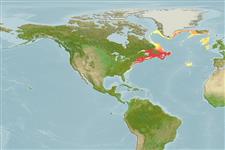Teleostei (teleosts) >
Gadiformes (Cods) >
Phycidae (Phycid hakes)
Etymology: Urophycis: Greek, oura = tail + Greek, phyke, pykis, -idos = the female of a fish that lives among algae (Greek = phykon), related with the gudgeon (Ref. 45335).
More on author: Mitchill.
Environment: milieu / climate zone / depth range / distribution range
Ecology
Marine; demersal; oceanodromous (Ref. 51243); depth range 100 - 1000 m (Ref. 5951), usually 100 - 247 m (Ref. 1371). Temperate; 66°N - 27°N, 81°W - 13°W
Western Atlantic: Labrador and the Grand Banks of Newfoundland to the coast of North Carolina. Straying to Iceland in the east and Florida in the south.
Length at first maturity / Size / Weight / Age
Maturity: Lm 46.0, range 48 - ? cm
Max length : 133 cm TL male/unsexed; (Ref. 40637); 135.0 cm TL (female); common length : 70.0 cm TL male/unsexed; (Ref. 1371); max. published weight: 21.0 kg (Ref. 4699); max. reported age: 23 years (Ref. 796)
Dorsal spines (total): 0; Anal spines: 0. Upper limb or first gill arch with 2 (rarely 3) rakers. First dorsal in with an elongated ray. Body color variable, dorsally various dark shades, paler laterally, sometimes bronze, belly pale dirty to yellow white; pelvic fin pale. A dusky blotch present on the opercle.
Found on soft, muddy bottoms of the continental shelf and upper slope. It is mostly found at 180 m. Mature fish migrate inshore in the northern Gulf of Maine in summer, disperse in autumn, and move into deepest areas in winter. Feed on small crustaceans, squids and small fish. Utilized fresh, smoked or frozen; eaten steamed, microwaved and baked (Ref. 9988). Exported to Europe (Ref. 9988).
Cohen, D.M., T. Inada, T. Iwamoto and N. Scialabba, 1990. FAO species catalogue. Vol. 10. Gadiform fishes of the world (Order Gadiformes). An annotated and illustrated catalogue of cods, hakes, grenadiers and other gadiform fishes known to date. FAO Fish. Synop. 125(10). Rome: FAO. 442 p. (Ref. 1371)
IUCN Red List Status (Ref. 130435)
Threat to humans
Harmless
Human uses
Fisheries: highly commercial; gamefish: yes
Tools
Special reports
Download XML
Internet sources
Estimates based on models
Preferred temperature (Ref.
123201): 1.2 - 7.8, mean 4.8 °C (based on 160 cells).
Phylogenetic diversity index (Ref.
82804): PD
50 = 0.5044 [Uniqueness, from 0.5 = low to 2.0 = high].
Bayesian length-weight: a=0.00398 (0.00337 - 0.00470), b=3.16 (3.11 - 3.21), in cm total length, based on LWR estimates for this species (Ref.
93245).
Trophic level (Ref.
69278): 4.3 ±0.5 se; based on diet studies.
Generation time: 10.4 ( na - na) years. Estimated as median ln(3)/K based on 2
growth studies.
Resilience (Ref.
120179): Low, minimum population doubling time 4.5 - 14 years (K=0.11; tm=2; tmax=23; Fec=1 million).
Prior r = 0.40, 95% CL = 0.26 - 0.59, Based on 3 full stock assessments.
Fishing Vulnerability (Ref.
59153): High to very high vulnerability (72 of 100).
Climate Vulnerability (Ref.
125649): Moderate to high vulnerability (53 of 100).
Nutrients (Ref.
124155): Calcium = 15.8 [9.1, 31.6] mg/100g; Iron = 0.316 [0.184, 0.544] mg/100g; Protein = 18.1 [16.8, 19.4] %; Omega3 = 0.602 [0.318, 1.095] g/100g; Selenium = 25.5 [14.3, 49.2] μg/100g; VitaminA = 12.8 [3.9, 41.9] μg/100g; Zinc = 0.325 [0.235, 0.457] mg/100g (wet weight);
